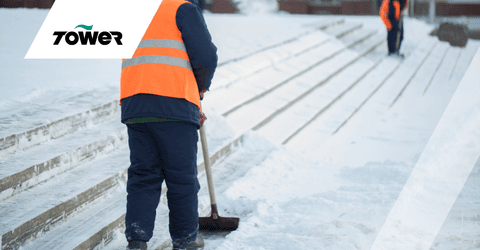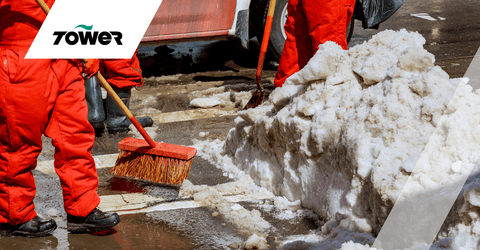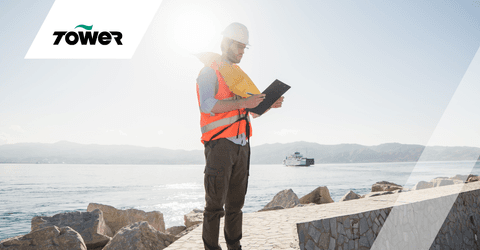
This guide will take you through some important seasonal protective clothing PPE considerations including specific winter PPE and summer PPE when working in the extremes of hot & dry and cold & wet outdoor conditions.
Wearing protective clothing PPE when dealing with the notoriously changeable British weather is a challenge facing anyone who works outside. On one hand you need to stay cool in the spring & summer, and on the other warm in the autumn & winter months. All whilst ensuring you’re wearing the right protective clothing PPE to stay safe and protected, without compromising productivity or your ability to do the task at hand.
This article will take you through some of the most important autumn & winter PPE and spring & summer PPE considerations when working during the extremes of hot & dry and cold & wet outdoor conditions.

Autumn & winter is a tough time for those that work outside. The average UK winter temperature is 0 to 7°C (32° - 45°F), with short days with low visibility and long cold nights. Cold and wet weather also brings a variety of hazards, and even normal tasks can become more difficult or dangerous. That’s why you need protective clothing PPE that can keep you warm, safe, and able to perform at your best.
The immediate effects of cold weather on the body can range from severely restricted movement to just simply reduced levels of concentration. Exposure to the cold can even result in serious conditions such as hypothermia and extended exposure to the cold can lead to a series of potential injuries. This makes the right autumn & winter protective clothing PPE essential to stay healthy and safe.
Some ways to protect against the cold include cold temperature protective clothing such as wearing gloves, thermals, and fleece jackets. But be sure to check the protective properties before allocating PPE to employees. Those working outside in the cold will also require Hi Vis cold protective garments to keep them visible and protected.
As fingers, toes and feet are particularly affected by cold weather, it’s important to have the appropriate protection in place to maintain dexterity and prevent nasty accidents. Thermal gloves and socks may be necessary to protect extremities, and a thermal hat can make a big difference.

It’s essential to have the correct autumn & winter PPE protective clothing if working outside to prevent cold stress. Correctly layering PPE provides the best protection against extended cold exposure and provides better insulation when cold temperatures or environments cannot be avoided.
We suggest wearing three specific layers to keep healthy, safe, and performing at your best:

The EN 342 standard are requirements and test methods for the performance of clothing ensembles. These effects comprise low air temperatures, humidity, and air velocity. The protective effects and requirements of footwear, gloves and separate headwear are excluded.
Employees working out in the cold may be exposed to heavy rain as well as below-zero temperatures. When garments meet this standard, you are assured it has both breathability and resistance to water penetration.
This standard relates specifically to high-visibility clothing. Hi vis clothing is usually worn outdoors, especially when working around moving vehicles. This standard specifies the baseline for retro-reflective tape and the three rated classes of protection.
Spring and especially summer can be a challenge for those that work with risk and require the right protective clothing all year round. Without the right summer PPE, the higher temperatures can cause a great deal of discomfort, especially for those who require several layers of significant protective clothing.
Lightweight and breathable spring & summer PPE is an ideal solution when the sun is out and when working in high outside temperatures. Being prepared with seasonally appropriate protective clothing and using the right layering is an effective way to stay safe and comfortable during the warmer months.

As challenging as it may be when working in the spring & summer, there can be no compromises when it comes to worker safety. The temptation to remove or not use layers of protection creates risk to employees and it’s essential that the right PPE is still worn at work.
To retain productivity and performance, protective clothing PPE can be adapted to increase ventilation whilst maintaining safety compliance. It’s also important to support employees and adapt the working structure with regular breaks to cool down and take on board plenty of water.
There are plenty of lightweight and breathable protective clothing PPE options for spring & summer. This includes hard hats, goggles, and gloves with built-in ventilation, or Hi Vis clothing made from moisture-wicking material and even cooling vests.
For those that require safety glasses for certain tasks, there are lenses offering different protection options, such as smoke-tinted for solar protection and reducing solar glare and yellow for ultraviolet filtering. Many safety glasses and goggles are also vented to allow airflow with an anti-mist coating.

EN 13758-2 is the standard for protective clothing for UV protective apparel. This standard specifies the requirements for making clothing designed to provide the wearer with protection against solar ultraviolet (UV) radiation.
This is for personal eye protection relating to sunlight filters for individual use. This standard specifies the scale numbers, transmittances, and related requirements for sun glare filters designed for industrial use.
This standard is for protective clothing for protection against solar and ultraviolet radiation. AS/NZS 4399 protective clothing provides protection against solar ultraviolet radiation exposure (UVA and UVB).